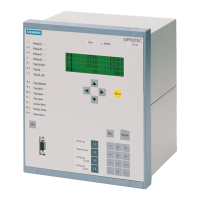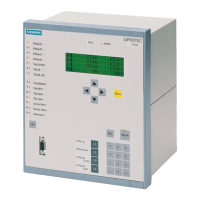Mounting and Commissioning
3.3 Commissioning
SIPROTEC, 7UM62, Manual
C53000-G1176-C149-7, Release date 03.2010
447
• Make sure that the protective function does not pick up on this current. It may be necessary to use different
excitation states.
• With the generator running, connect a test resistor (0 - 30 Ω) between generator shaft and earth using a slip-
ring in the vicinity of the bearing. Reduce the resistance value until the protection picks up. If the pickup con-
dition „chatters“, increase the holding time slightly at address 5407. This time should not be longer than one
second.
After the test is completed, activate the sensitive earth current protection by setting address 5401 to = ON.
3.3.22 Creating Oscillographic Fault Recordings for Tests
General
At the end of commissioning, closing tests may be carried out to assure the stability of the protection during the
dynamic processes. A maximum of information on protection behaviour is supplied by fault recordings.
Prerequisite
Along with the possibility of storing fault recordings via pickup of the protection function, the 7UM62 also has
the capability of capturing the same data when commands are given to the device via the service program
DIGSI, the serial interface, or a binary input. For the latter event, „>Trig.Wave.Cap.“ must be allocated to
a binary input. Triggering of the recording then occurs, for example, via the binary input when the protected
object is energised.
Such externally started test fault recordings (i.e., without a protection pickup) are handled by the device as
normal fault recordings, i.e. for each measurement record a fault log is opened with its own number, for un-
equivocal allocation. However, these recordings are not displayed in the fault indication buffer, as they are not
fault events.
Triggering Oscillographic Recording
To trigger test measurement recording with DIGSI, click on Test in the left part of the window. Double click the
entry Test Wave Form in the list of the window.

